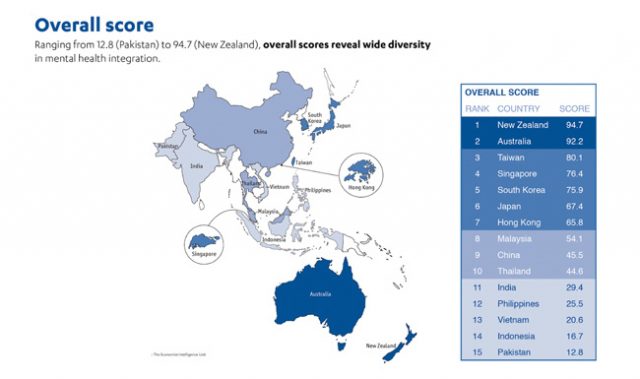
AsianScientist (Feb. 24, 2014) – Asia’s economic growth has been one of the success stories of the 21st century. But the economic rise of countries such as China, India, Vietnam and Indonesia has created serious pressure on their environmental resources, particularly their water supplies.
A recent study by the Bertelsmann Foundation suggests that countries tend to prioritize economic growth over environmental protection. It is only after countries reach high levels of economic development that they begin to invest time and money into safeguarding environmental resources. Upper-middle-income China and India, as well as lower-middle-income Vietnam and Indonesia, have all begun the task of creating policy regimes to secure the safety of their water resources.
But making policy and implementing it are two different things, and none of the countries have gone far enough to create a safe water regime that can meet the needs of their populations as well as their economies.
In China, pollution has rendered the water so unsafe that less than half of the water can be treated to the point where it would be safe to drink, and a quarter of surface waters are unusable even for industrial needs.
In India, one in eight people do not have access to clean drinking water and three-quarters of all diseases are caused by contaminated water. Up to 80 percent of diseases in Vietnam are attributable to the effects of water pollution. And in Indonesia, according to the World Bank, untreated sewage results in six million tons of human feces being released into inland water bodies every year, contributing to the serious water pollution that means half the population has no access to clean water.
In each of these countries, the poor are more seriously affected than the wealthy, adding to the growth of inequality and forcing the weakest members of society to bear the cost of economic development.
All four countries have taken steps to introduce a regulatory and policy regime to address the problem. But none of them has succeeded in building a policy regime that effectively protects environmental and water resources. China receives a score of 2 out of a possible 10 on environmental policy in the Bertelsmann Foundation’s study. This low score comes in spite of the fact that China has created a raft of policies and initiatives aimed at ameliorating its environmental woes.
Its water pollution law in 2008 introduced greater penalties for water polluters, while new regulations mandate that 95 percent of water tested should meet national guidelines for water quality. But China’s water policy faces the same challenges in implementation as the rest of its environmental regulations.
Monitoring, implementation and enforcement is often delegated to local authorities, which often prioritize the industrial interests who provide employment and economic development. Rapid industrial development and increased use of water-intensive crops such as wheat make the situation even graver. Without improvements in the regulatory environment, China’s water shortage problems will not improve.
India scores 5 out of 10 on environmental policy in the study. The country’s inability to safeguard its resources shows that policy failure is not confined to authoritarian governments: despite the interest of the electorate in accessing clean water, democratic processes alone cannot ensure policy is effectively implemented.
In India, environmental protection is enshrined in the constitution. India introduced the National Water Policy in 2012, which among other measures envisaged the establishment of a national water regulatory body. A draft National Water Framework Law was circulated in 2013, although critics charge that it does not go far enough in uprooting the status quo. But in spite of all these policy initiatives, the country does not have the institutional capacity to enforce its environmental regulations.
The Bertelsmann study shows that environmental programs are underfunded and inspection and monitoring programs are inadequate. As a result, the country stands to lose out in human and economic terms. The World Bank estimates that the cost to India of water and air pollution as well as soil degradation comes to 5.7 percent of the country’s GDP.
Like China, Indonesia scores 2 out of 10 on environmental policy. The country has signed up to the Millennium Development Goal of halving the number of people without access to clean water by 2015. Beginning in the 1990s, water companies were privatized to try and improve investment in water supply in the country.
But Indonesia’s water companies provided clean water to only 42 percent of urban residents and 14 percent of rural residents in 2012, in part because many of these private-sector companies are facing financial difficulties. Indonesia introduced a new water resources law in 2004, but corruption, institutional incapacity and weak governance make the new law difficult to effectively implement.
Vietnam scores 5 out of 10 on environmental policy. The Bertelsmann study suggests that Vietnam is working hard to strengthen the policy framework for environmental management, introducing high-level policy documents such as the National Strategy for Environmental Protection in 2010. But overuse of waterways for irrigation, industry and hydropower creates pollution and causes health problems for users of contaminated water — diarrhea is one of the major causes of disease and illness in the country.
Environmental impact assessments are conducted before projects are implemented, but their recommendations are regularly ignored. Overseas companies, especially from Taiwan and South Korea, contribute to Vietnam’s industrial pollution, but local authorities are reluctant to enforce strictures against them. The government needs to create policy to limit the exploitation of waterways and to increase enforcement of existing legislation.
China, India, Indonesia and Vietnam have all created policy regimes to secure the safety of their water resources in recent years. But it’s not enough to simply introduce water management policies — it’s time to work towards effectively implementing them.
Justine Doody is an editor for the China & Asia and Wider Europe programs of the European Council on Foreign Relations (ECFR). She is the English-language editor of China Analysis, a quarterly survey of current thinking in Chinese academic and policy circles, published by ECFR in cooperation with the Asia Center in Paris. She is also a writer for the Bertelsmann Stiftung’s SGI News and the BTI Blog. The views expressed herein are the author’s own.
——
Source: East Asia Forum.
Disclaimer: This article does not necessarily reflect the views of AsianScientist or its staff.











